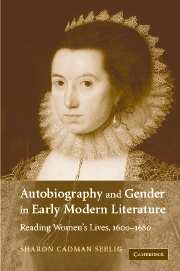Book contents
- Frontmatter
- Contents
- Preface
- Introduction: mapping the territory
- 1 Margaret Hoby: the stewardship of time
- 2 The construction of a life: the diaries of Anne Clifford
- 3 Pygmalion's image: the lives of Lucy Hutchinson
- 4 Ann Fanshawe: private historian
- 5 Romance and respectability: the autobiography of Anne Halkett
- 6 Margaret Cavendish: shy person to Blazing Empress
- Conclusion: “The Life of Me”
- Notes
- Bibliography
- Index
5 - Romance and respectability: the autobiography of Anne Halkett
Published online by Cambridge University Press: 22 September 2009
- Frontmatter
- Contents
- Preface
- Introduction: mapping the territory
- 1 Margaret Hoby: the stewardship of time
- 2 The construction of a life: the diaries of Anne Clifford
- 3 Pygmalion's image: the lives of Lucy Hutchinson
- 4 Ann Fanshawe: private historian
- 5 Romance and respectability: the autobiography of Anne Halkett
- 6 Margaret Cavendish: shy person to Blazing Empress
- Conclusion: “The Life of Me”
- Notes
- Bibliography
- Index
Summary
In the autobiography of Anne Murray Halkett we come to a text that is more fully fashioned, more self-conscious and focused in its presentation than those I have been discussing. Unlike Lucy Hutchinson, who gives herself a number of (albeit important) scenes within the life of her husband, or Ann Fanshawe, who tells her story in the context of a family history that centers on her husband's professional career and places her in a supporting role, Anne Halkett sets out to tell her own story, perhaps with the intention of justifying her actions to posterity. Although Halkett resembles her contemporaries in having no single biographical model available to her – indeed, the shifting generic patterns are an important feature of her work – her presentation has a strength and coherence of narrative line that takes it beyond the episodic and moves at times to a style surprisingly close to that of the eighteenth-century English novel. In what follows, I shall concentrate on the diverse models of self-presentation and narrative used by Halkett in her autobiography, strategies that partake of devotional treatise, family history, and romance.
Anne Murray Halkett, daughter of Thomas Murray, provost of Eton College and tutor to Charles I, was born January 4, 1623, a few months before the death of her father. In her early twenties, she was courted by Thomas Howard, eldest son of Thomas, Lord Howard of Escrick: the match was forbidden by her mother on the grounds of inequity of fortune, the Howards having much more to offer and hence to expect than the Murrays.
- Type
- Chapter
- Information
- Autobiography and Gender in Early Modern LiteratureReading Women's Lives, 1600–1680, pp. 110 - 130Publisher: Cambridge University PressPrint publication year: 2006

